|
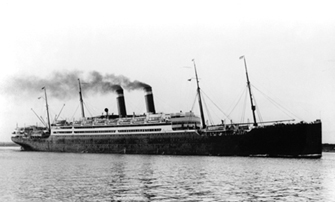
Amerika / America (I)
Built by Harland & Wolff of Belfast, Hapag's Amerika was launched in
April 1905, and made her Hamburg-New York maiden voyage on 11 October of
the same year.
On 4 October 1912, while still on the New York service, she rammed the
British submarine B2 off the coast of Dover. The sub sank immediately and
15 of her 16 crew members perished.
In June 1914, Amerika was transferred to Hapag's Hamburg-Boston
service, and was in Boston when World War I began. She was interned there
from August 1914 until the United States entered the war in April 1917.
She was then seized, renamed America, and put into service as a troopship.
Her service as trooper was hardly a tranquil one, for she was involved in
two fatal incidents in 1918. On 14 July, she collided with the British
steamer Instructor, which sank with 16 deaths. Three months later, on 15
October, America herself sank while taking on coal in Hoboken, with six
fatalities. She was raised in December and repaired, returning to service
in February 1919.
Retained after the war by the United States as a war reparation,
America underwent a refitting and conversion to oil fuel at Morse Dry Dock
& Repair Co. in Brooklyn during 1920-21. In June and July 1921, she
was chartered to U.S. Mail Steamship Co., and made three New York to
Bremen roundtrips for that company. She then became part of United States
Lines, and was placed on the New York-Bremerhaven service in August 1921.
America was rebuilt in 1923 at the Brooklyn Navy Yard, and again in
1926 at Newport News Shipbuilding. During the 1926 rebuilding, America was
so badly damaged by fire that her scrapping was seriously considered. In
the end, though, she was repaired and returned to service in March 1928.
She remained in service only another three and a half years, making her
final westbound departure, from Hamburg, on 4 September 1931. She was then
laid up in Chesapeake Bay until 1940.
In October of that year, America was sent to Bethlehem Steel's
Baltimore ship yard for conversion into a U.S. Maritime Commission
accommodation ship named Edmund B. Alexander. In 1942-43, she underwent a
further conversion into a trooper, again at Bethlehem Steel in Baltimore,
emerging with only a single funnel. She served as a trooper until May
1949, when she was again laid up, first at Baltimore, and after 1951 in
the Hudson River. In 1957 she was sold to Bethlehem Steel for scrapping,
which took place at Baltimore in 1958.
An aside: Several sources, including Miller's Pictorial Encyclopedia of
Ocean Liners 1860-1994, Kludas' Great Passenger Ships of the World and
Haws' Merchant Fleets, state that Amerika was the largest ship in the
world during the 1905-06 time frame. This is clearly not correct. By any
measure, White Star's Baltic
(II) was a larger and older ship than Amerika. Baltic was
clearly bigger (by more than 1,000 tons) and longer (by 26 feet) and had a
larger passenger capacity (by 367). Her launch and maiden voyage preceded
Amerika's by 17 months and 16 months, respectively. Baltic therefore was
older than Amerika and there's no standard by which Amerika can be judged
to be larger than Baltic. Amerika was never, in fact, the world's largest
ship.
Sources: Bonsor's North Atlantic
Seaway; Kludas' Great Passenger Ships of the World.
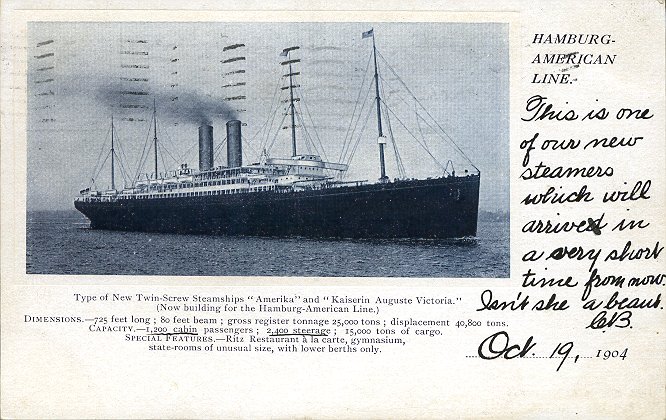 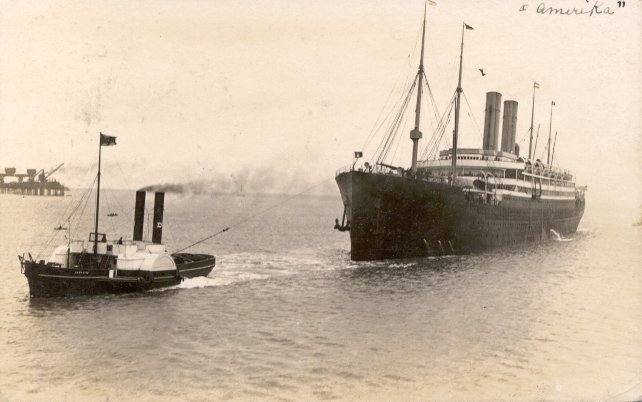
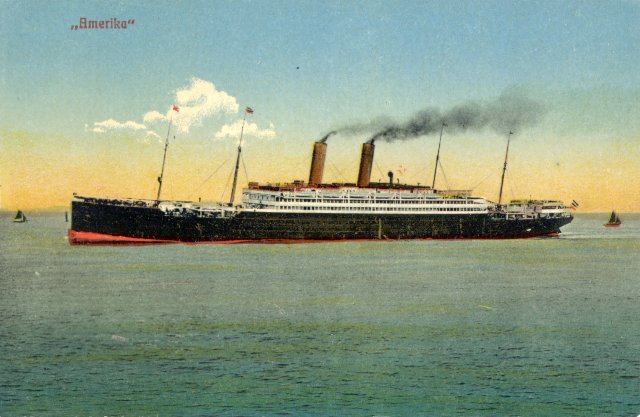 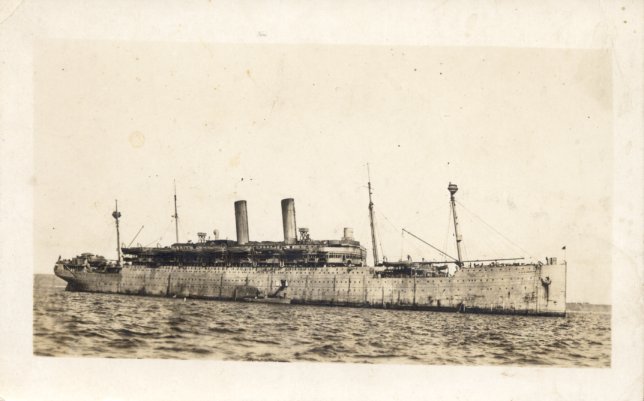
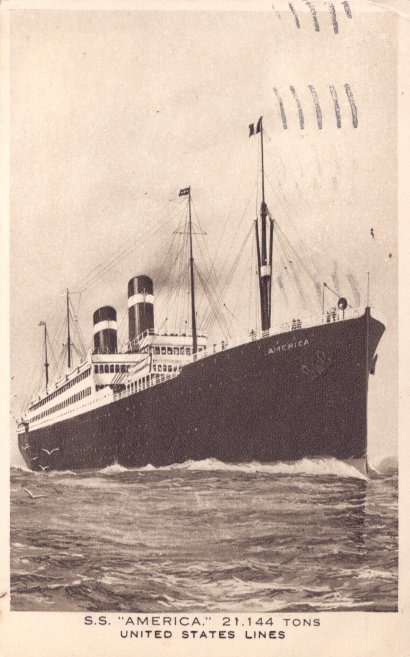
|
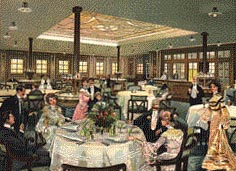
|
| The popular
Ritz-Carlton Restaurant on board the Amerika. |
S.S. Amerika
The ship set a new standard of
excellence for ocean travel when it sailed from Hamburg, Germany on the maiden
voyage to New York on Oct. 1, 1905. Owned by the Hamburg-Amerika Line, the
new ship was designed to attract passengers with unmatched luxury and superior
service without attempting to make any speed records.
 The
668 foot long, 22,225 gross ton liner boasted many technological innovations
including a Marconi Wireless system, an automatic fire extinguishing system
and electrically controlled watertight doors that could be operated from the
bridge. The ship could accommodate 420 first class, 254 second class, 223
third class and 1,765 steerage passengers. Passenger comforts were second to
none and included the first passenger elevator aboard an ocean liner. The
elevator was a great attraction and made 1,825 trips during the maiden voyage. The
668 foot long, 22,225 gross ton liner boasted many technological innovations
including a Marconi Wireless system, an automatic fire extinguishing system
and electrically controlled watertight doors that could be operated from the
bridge. The ship could accommodate 420 first class, 254 second class, 223
third class and 1,765 steerage passengers. Passenger comforts were second to
none and included the first passenger elevator aboard an ocean liner. The
elevator was a great attraction and made 1,825 trips during the maiden voyage.
 This separate dining room seated 120 guests under a stained glass skylight and
portholes were replaced with large square windows offering panoramic views.
The concept proved so popular, the Ritz-Carlton restaurants were installed on
other Hamburg-Amerika liners and later copied by other European steamship
lines.
This separate dining room seated 120 guests under a stained glass skylight and
portholes were replaced with large square windows offering panoramic views.
The concept proved so popular, the Ritz-Carlton restaurants were installed on
other Hamburg-Amerika liners and later copied by other European steamship
lines.
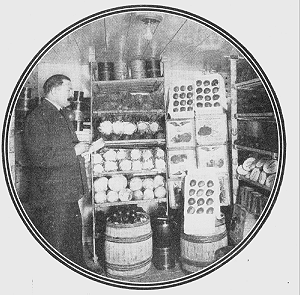 The year was 1912 and the Amerika's Chief Steward, G. Scholz, making a
morning inspection of one of the ship's food storerooms. The Chief Steward
supervised all activities in the nine kitchens that provided food for the
passengers' superb dining experiences. The kitchens included one exclusively
for the Ritz-Carlton a la carte restaurant on board, two kitchens for steerage
passengers and a kosher kitchen for orthodox Hebrew travelers.
The year was 1912 and the Amerika's Chief Steward, G. Scholz, making a
morning inspection of one of the ship's food storerooms. The Chief Steward
supervised all activities in the nine kitchens that provided food for the
passengers' superb dining experiences. The kitchens included one exclusively
for the Ritz-Carlton a la carte restaurant on board, two kitchens for steerage
passengers and a kosher kitchen for orthodox Hebrew travelers.
Afternoon tea served promptly at 4 was a
tradition at sea aboard the trans-Atlantic liners. Here on the Amerika's Promenade
Deck, attentive stewards served tea, cakes and small sandwiches to the
passengers.

The S.S. Amerika sent a wireless
message on April 14, 1912 reporting the location of two large icebergs in the
North Atlantic. Several hours later the Titanic struck an iceberg and
sank in the same area. When World War I broke out, the ship was interned in
the U.S. and later seized when the U.S. entered the war and renamed S.S.
America. Over the next forty years under the American flag, the liner was
used in service as a passenger liner, troop ship and spent several lengthy
periods laid up in storage. She was scrapped in 1957 having sailed longer and
further than many of the more famous liners built in the early 1900s.
|  The
668 foot long, 22,225 gross ton liner boasted many technological innovations
including a Marconi Wireless system, an automatic fire extinguishing system
and electrically controlled watertight doors that could be operated from the
bridge. The ship could accommodate 420 first class, 254 second class, 223
third class and 1,765 steerage passengers. Passenger comforts were second to
none and included the first passenger elevator aboard an ocean liner. The
elevator was a great attraction and made 1,825 trips during the maiden voyage.
The
668 foot long, 22,225 gross ton liner boasted many technological innovations
including a Marconi Wireless system, an automatic fire extinguishing system
and electrically controlled watertight doors that could be operated from the
bridge. The ship could accommodate 420 first class, 254 second class, 223
third class and 1,765 steerage passengers. Passenger comforts were second to
none and included the first passenger elevator aboard an ocean liner. The
elevator was a great attraction and made 1,825 trips during the maiden voyage.
 This separate dining room seated 120 guests under a stained glass skylight and
portholes were replaced with large square windows offering panoramic views.
The concept proved so popular, the Ritz-Carlton restaurants were installed on
other Hamburg-Amerika liners and later copied by other European steamship
lines.
This separate dining room seated 120 guests under a stained glass skylight and
portholes were replaced with large square windows offering panoramic views.
The concept proved so popular, the Ritz-Carlton restaurants were installed on
other Hamburg-Amerika liners and later copied by other European steamship
lines.
 The year was 1912 and the Amerika's Chief Steward, G. Scholz, making a
morning inspection of one of the ship's food storerooms. The Chief Steward
supervised all activities in the nine kitchens that provided food for the
passengers' superb dining experiences. The kitchens included one exclusively
for the Ritz-Carlton a la carte restaurant on board, two kitchens for steerage
passengers and a kosher kitchen for orthodox Hebrew travelers.
The year was 1912 and the Amerika's Chief Steward, G. Scholz, making a
morning inspection of one of the ship's food storerooms. The Chief Steward
supervised all activities in the nine kitchens that provided food for the
passengers' superb dining experiences. The kitchens included one exclusively
for the Ritz-Carlton a la carte restaurant on board, two kitchens for steerage
passengers and a kosher kitchen for orthodox Hebrew travelers.








